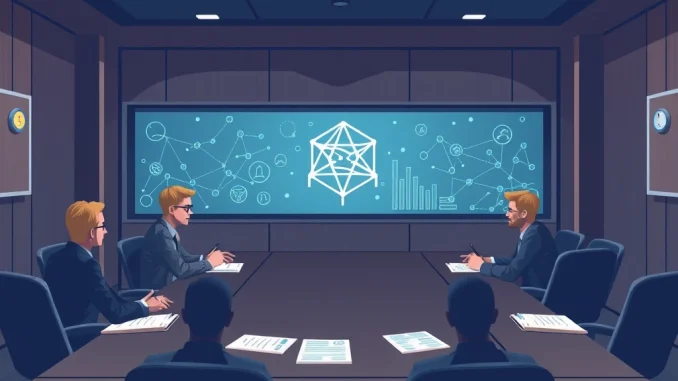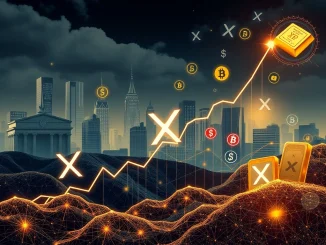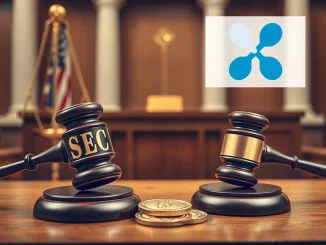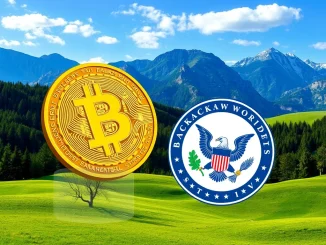
The world of crypto regulation is constantly evolving, and recent interactions between U.S. regulators and industry players offer key insights into the path forward. A significant development involves the U.S. Securities and Exchange Commission (SEC) and its direct engagement with platforms building the future of finance. Specifically, a crucial meeting recently took place, putting the spotlight squarely on **SEC crypto regulation** and the emerging landscape of tokenized assets.
What Happened at the Crucial SEC Crypto Regulation Meeting?
On June 20, members of the U.S. SEC’s dedicated Crypto Task Force held a follow-up meeting with representatives from Dinari, a platform specializing in real-world asset (RWA) tokenization. The meeting also included legal counsel from the firm WilmerHale. This gathering wasn’t just a casual chat; it was a direct engagement to discuss pertinent regulatory issues surrounding crypto assets.
According to an official memorandum from the SEC, this meeting built upon a prior discussion held on May 1. The primary goal for Dinari was to provide more detailed information regarding their proposed system. What system, you ask? One designed for trading tokenized securities across multiple blockchain networks. The agenda for this follow-up included two key components:
- A demonstration showcasing the architecture of Dinari’s proposed trading system.
- A discussion centered around the legal framework underpinning the system’s operations.
This level of detailed engagement signals the SEC’s increasing focus on understanding the technical and legal nuances of specific crypto applications, especially those blurring the lines between traditional finance and digital assets.
Diving Deeper: Dinari and Tokenized Securities
Dinari operates in the fascinating space of **tokenized securities**. But what exactly are these? In simple terms, tokenized securities are digital representations of traditional financial assets (like stocks, bonds, or real estate) issued and managed on a blockchain. They fall under the broader umbrella of Real-World Asset (RWA) tokenization.
The concept behind tokenized securities is to bring the benefits of blockchain technology – such as increased liquidity, fractional ownership, transparency, and potentially faster settlement – to traditional asset classes. Instead of owning a physical stock certificate or a share recorded in a traditional ledger, you own a digital token on a blockchain that represents that share.
Dinari’s specific focus, as discussed with the SEC, is on building a system that can facilitate the trading of these tokenized securities not just on one blockchain, but across several different networks. This interoperability is a complex technical challenge but holds the promise of creating more connected and efficient global markets for tokenized assets.
Why is RWA Tokenization on the SEC’s Radar?
**RWA tokenization** is gaining significant traction in the blockchain space. Financial institutions and crypto companies alike see its potential to unlock value and create new investment opportunities. However, when you tokenize assets that are already considered securities under existing laws, or when you create new digital assets that function like securities, it naturally draws the attention of financial regulators like the SEC.
The SEC’s mandate includes protecting investors and maintaining fair and orderly markets. When new technologies like blockchain are applied to securities, the SEC needs to understand how these systems work, how they comply with existing regulations, and whether new rules or guidance are necessary to ensure investor protection and market integrity in the digital age.
Key questions regulators are grappling with include:
- How are these digital tokens classified legally? Are they securities, commodities, or something else?
- How are transactions recorded and settled on a blockchain in a way that meets regulatory requirements?
- How are investors protected from fraud, manipulation, and operational risks?
- How do regulations apply when these tokenized assets are traded across different blockchains or jurisdictions?
Dinari’s meeting with the SEC indicates that the agency is actively engaging with platforms at the forefront of RWA tokenization to find answers to these complex questions.
What Does This Mean for Crypto Regulation?
This specific meeting between the SEC and Dinari is a microcosm of the larger conversation happening around **crypto regulation** in the United States. It highlights a few key trends:
- **Increased Specificity:** The SEC isn’t just issuing broad statements; they are engaging directly with specific companies and diving into the details of their technology and proposed operations.
- **Focus on Functionality:** The regulatory focus is often on *what* a digital asset or platform *does*, rather than simply calling it “crypto.” If it functions like a security, it will likely be subject to securities laws.
- **Dialogue is Happening:** Despite ongoing enforcement actions and debates, there is also dialogue occurring between regulators and industry participants trying to build compliant systems.
Meetings like this are crucial for both sides. They allow the SEC to gain a deeper technical understanding of complex systems like cross-chain tokenized security trading. They also provide companies like Dinari an opportunity to explain their approach, highlight their efforts towards compliance, and seek clarity on regulatory expectations.
The Role of the Dinari Platform in This Discussion
The **Dinari platform** serves as a concrete example for the SEC to analyze the practical challenges and proposed solutions for regulating tokenized securities. By demonstrating its system architecture and discussing its legal framework, Dinari is directly contributing to the regulatory learning process within the SEC.
Their focus on cross-chain trading adds another layer of complexity, touching upon issues of interoperability and how regulatory oversight can function across disparate networks. The SEC’s willingness to engage on these technical details suggests a genuine effort to understand the mechanics of the next generation of financial infrastructure being built on blockchain.
Key Takeaways from the Meeting
For those watching the space, this meeting underscores several important points:
- **RWA Tokenization is a Regulatory Priority:** The SEC is actively looking at how to oversee platforms dealing with tokenized real-world assets.
- **Technical Details Matter:** Companies need to be prepared to explain the intricacies of their technology to regulators.
- **Legal Framework is Paramount:** A robust legal strategy and clear compliance plan are essential for operating in the tokenized securities space.
- **Engagement is Ongoing:** While challenges remain, dialogue between the industry and regulators is happening.
Challenges Ahead
Despite positive engagement, significant challenges remain in regulating tokenized securities and RWAs. Ensuring consistent oversight across different blockchain protocols, dealing with global regulatory variations, and adapting existing laws to decentralized technologies are just a few hurdles. The path to clear and comprehensive **crypto regulation** is long, but meetings like the one with Dinari represent steps forward in understanding the complexities involved.
Conclusion: A Step Towards Clarity?
The SEC’s follow-up meeting with Dinari on June 20 is a significant event in the ongoing dialogue around **SEC crypto regulation**. By focusing specifically on **tokenized securities** and **RWA tokenization**, the SEC is demonstrating its intent to understand and potentially regulate this burgeoning area of digital finance. The detailed discussion of the **Dinari platform**’s architecture and legal framework highlights the depth of the technical and legal considerations involved. While the road to regulatory clarity for crypto assets, particularly complex ones like cross-chain tokenized securities, is still being paved, direct engagements like this meeting are crucial steps in that process, offering a glimmer of hope for future frameworks.



